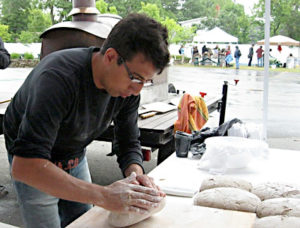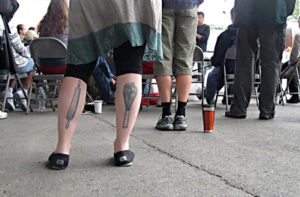 |
| Barak Olins of Zu Bakery, making bread at the Kneading Conference. Photo by Amy Halloran. |
By Amy Halloran
The Kneading Conference (https://kneadingconference.com/) began in 2007 with a few tents and mobile ovens in a church parking lot. Now those tents and ovens congregate at the Skowhegan fairgrounds each July, drawing people from all over the world to Maine for hands-on bread workshops, for talks and presentations on all the things that lead to bread – especially ovens and grains.
Some bakers say the fuel of the conference feeds them in their kitchens at work and at home.
That energy feeds other fires, too – including the idea of growing grains in Maine. While the state was one of the breadbaskets for the Union Army in the Civil War, over time grain production and milling shifted west. Many have forgotten this history and think that grains don’t grow in Maine. The conference and the Maine Grain Alliance (MGA) – the nonprofit that runs the conference and other grain activities year-round – are changing that.
While Maine acreage in food-grade grains is still minimal, just getting bakers thinking about where flour comes from is building market interest and helping farmers re-imagine what crops are possible.
The conference is stocked with stories that build such possibilities. In July 2012, farmer Thor Oechsner, baker Stefan Senders and miller Greg Mol from central New York state described how their grain-based enterprises intersect and support each other. Farmer Ground Flour, a small stone mill outside Ithaca, sells flour from organic grains grown by Oechsner and other farmers to bakeries and individuals in New York City and elsewhere. Senders’ Wide Awake Bakery runs on a CSA model and functions as a test bakery for the mill. Other bakers can talk to Senders about managing the idiosyncratic performance of local flour, which can vary more than national brands.
 |
| A serious baker! Photo by Amy Halloran. |
Last July, conference keynote speaker Jim Amaral of Borealis Breads, which was celebrating its 20th anniversary, gave a retrospective of Maine grains and artisan bread. He recalled that Russell Libby, MOFGA’s late executive director, had steered him toward a meeting of organic dairy farmers when Amaral asked about sourcing local flour. At the dairy meeting, Amaral met Matt Williams, small grains specialist from the University of Maine; Williams would be key in sourcing local grains.
Amaral next visited Speerville Flour Mill in New Brunswick, which had created a network of farmers to grow wheat for flour.
Williams planted 35 acres of wheat in that first, 1999 season, stored it, and Amaral had it custom milled. In 2002, Williams opened his own stone mill, Aurora Mills and Farm. Borealis Breads and other customers now use this Maine-grown and ground whole-wheat flour in their whole wheat breads.
“I think we have a good future for grains in Maine because of the desire for more locally sourced food,” said Williams in a phone interview for this story. “A lot of my customers are more concerned where their grain is grown than anything else.”
Locavores and bakers alike are drawn to The Kneading Conference’s intensive bread baking workshops. Panels at the conference focus on how to farm and handle food-grade grains and how to use local flours. This helps develop markets for grains – the first step toward building the infrastructure critical to any food venture success.
Infrastructure is especially tough for grains because the equipment investment is huge. Grains can be planted and harvested by hand, but growing them at a scale that will pay for a farmer’s time usually requires specialized tools, such as grain drills for planting and combines for harvesting. Postharvest handling requires storage bins and drying capacity, since in Maine’s climate, ripe grain may be harvested when its moisture content is not ideal.
Cleaning and dehulling equipment are also necessary – and are available at the Somerset Grist Mill. This mill grew out of the conference, which Amber Lambke first organized. For years Lambke and her business partner, baker Michael Scholz, tried to get a mill to come to Skowhegan. Eventually they realized they had to undertake the task themselves.
Built in the former county jail, the mill grinds grains and rolls oats, all from Maine-grown crops. The flour and oats are on the shelves of home bakers and in the loaves from commercial bakeries, such as The Bankery in Skowhegan. Whole Foods in Portland began selling the grains in retail bags and in its bulk section in the fall of 2013, and Whole Foods’ regional production bakery in Boston is also using the flour.
“I think they’re such mutually beneficial ties,” Lambke said, noting that the conference and the MGA have heightened the knowledge base around Maine. “That makes it much easier for me to be doing my work at the mill to source and cultivate grains.”
Ellen Mallory from the University of Maine and the MGA board believes the conference and mill are building the confidence farmers need to move into grains, as they watch the market and consider whether it will work for them.
“It takes awhile for farmers to believe that this market’s going to be around, and that they’re going to be able to pay their bills,” said Mallory.
The MGA promotes grains in many ways – through, for example, baking education projects in the kitchen at the former jail and elsewhere, sometimes using its mobile bread oven; and through small technical assistance grants for grain-related businesses. It funded marketing and branding projects for Aurora Mills and for Grange Corner Farm in Lincolnville. Joel Alex’s Blue Ox Malt also got a grant, as did the Bankery, and the Bread Shack in Auburn.
The conference also helped develop Tortilleria Pachenga in Portland, which uses corn from Songbird Farm and Sandy River Farms. And baker Derek DeGreer, who attended the conference as a work-study participant, founded the Hootenanny Bakery in Damariscotta, which sells to farmers’ markets.
The MGA is also growing out seed varieties of heritage grains. Eli Rogosa, Will Bonsall and Elizabeth Dyck have researched and identified heritage varieties that do well in small-scale organic systems in the Northeast. While consumers want these foods, seeds are not available in commercial-scale quantities. Farmers who want to grow these types must commit to growing out small samples of the seeds, which can take five years. The MGA wants to accelerate that process.
“They found four farms interested in the project,” said Julie Zavage, who used to work at the Somerset Grist Mill and now coordinates the seed propagation project. Farmers get some familiarity with these varieties and a small stipend for planting garden-size plots of ‘Sirvanta’, ‘Rouge de Bordeaux’, ‘Banatka’, ‘Black Emmer’, ‘Einkorn’ and a heritage rye from Denmark.
Sam Mudge of Grange Corner Farm grows some of these varieties on his 9-acres of grain. He apprenticed at Webb Family Farm, where his grain is milled, and sells grains largely by word-of-mouth. He spoke at the Kneading Conference last summer about the challenges of locating appropriate scale equipment and other hurdles he’s facing as he enters the business. He sees the conference as cross-pollinating many people and projects.
“I think the university research (in Canada as well as Maine and Vermont) has really gotten the word out to the general farming community about bringing that part of farming back to the Northeast,” said Mudge. He likes seeing bulletins about rye, or about handling weeds in grains, and finds Jack Lazor’s book, The Organic Grain Grower, a wealth of information. “The momentum is continuing to gather. I’m happy to be riding the wave.”
About the author: Amy Halloran is writing a book about regional grain production and her obsession with pancakes. She lives in upstate New York and writes about grains at ZesterDaily.com, FromScratchClub.com and on her blog, AmyHalloran.com.
